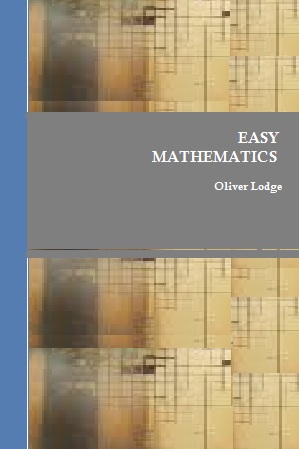Easy Mathematics: Arithmetic and Algebra for General Readers by Oliver Lodge - Free PDF

About this book :-
"Easy Mathematics: Arithmetic and Algebra for General Readers" by Sir Oliver Lodge is a "classic mathematics book" aimed at making arithmetic and algebra accessible to a wide audience. First published in 1910, the book was designed for teachers, parents, self-learners, and adults who want to strengthen their understanding of basic mathematics. Lodge’s goal was to simplify complex concepts, making them practical and understandable for everyday use, while fostering a love for the subject.
The book covers essential topics such as "arithmetic operations", number theory, fractions, decimals, and introductory "algebra". Lodge emphasizes clarity and step-by-step explanations, using examples that readers can relate to in real-life situations. Exercises throughout the book help reinforce learning, gradually building the reader’s confidence in handling both numerical and algebraic problems.
Lodge’s approach combines practicality with accessibility, making the book a valuable resource even today. While it reflects the teaching methods of its time, its emphasis on logical thinking and problem-solving remains relevant. "Easy Mathematics" is ideal for anyone looking to revisit foundational math, assist students with learning, or build confidence in their "mathematical skills". Its clear explanations and approachable style ensure readers can grasp essential concepts without feeling overwhelmed.
Book Detail :-
Title:
Easy Mathematics: Arithmetic and Algebra for General Readers by Oliver Lodge - Free PDF
Publisher:
The Macmillan Company
Year:
1910
Pages:
466
Type:
PDF
Language:
English
ISBN-10 #:
1019841869
ISBN-13 #:
978-1019841860
License:
Public Domain Work
Amazon:
Amazon
About Author :-
The author
Sir Oliver Joseph Lodge
(1851–1940) was a renowned British "physicist", educator, and author, famous for his contributions to electromagnetism and his dedication to making science accessible. He served as the first principal of the University of Birmingham and was knighted in 1902 for his scientific achievements. In his 1910 book, "Easy Mathematics: Arithmetic and Algebra for General Readers", Lodge aimed to simplify arithmetic and "algebra" for teachers, parents, and self-learners. His clear explanations and practical examples helped readers strengthen their "mathematical skills", making foundational concepts approachable and relevant for everyday use.
Book Contents :-
1. The very beginnings. Counting. Extension or application of the idea of number to measuring continuous quantity. Introduction of the idea of fractions. Practical hints for teaching the simple rules. Addition. Subtraction. Multiplication. Multiplication of money. Division. Division of money. Origin of the symbols
2. Further considerations concerning the Arabic system of notation, and extension of it to express fractions decimally and duodecimally.
3. Further consideration of division and introduction of vulgar fractions. Extension of the term multiplication to fractions. Practical remarks on the treatment of fractions.
4. Further consideration and extension of the idea of subtraction. Addition and subtraction of negative quantities
5. Ceneral tuition and extension of the ideas of multiplication and division to concrete quantity. First idea of involution
6. Factors of simple numbers
7. Dealings with money and with weights and measures. Modern treatment of the rule called "practice." The practical advantages of decimalisation. Decimalisation of money. Typical exercises. Binary scale. Decimal system of weights and measures. Decimal measures. Angles and time. Further exercises
8. Simple proportion. Breakdown of simple proportion or *' rule of three "
9. Simplification of fractions
10. Greatest common measure and least common multiple. Rule for finding G.C.M. Algebrical statement of the process for finding G.C.M.
11. Easy mode of treating problems which require a little thought
12. Involution and evolution and beginning of indices
13. Equations treated by the method of very elementary experiment. Further consideration of what can be done to equations
14. Another treatment of equations. Introduction to quadratics
15. Extraction of simple roots. Surds
16. Further consideration of indices. Fractional indices. Negative indices
17. Introduction to logarithms
18. Logarithms. Common practical base. Examples. Examples for practice. Fundamental relations
19. Further details about logarithms
20. On incommersurables and on discontinuity
21. Concrete arithmetic. The meaning of significant figures and practical accuracy
22. Practical manipulation of fractions when decimally expressed. "Order" of numbers
23. Dealings with very large or very small numbers
24. Dealings with vulgar fractions. Numerical varifications
25. Simplification of fractional expressions
26. Cancelling among units
27. Cancelling in equations. Caution
28. Further cautions. Cautious of a slightly more advanced character
29. Illustrations of the Practical Use of Logarithms.
(i). How to look out a logarithm,
(ii). How to look out the number which has a given logarithm. Examples. Logarithms of fractions,
(iii). How to do multiplication and division with logs.
30. How to find powers and roots by logarithms. Exercises. Roots of negative numbers
31. Geometrical illustration of powers and roots. Further geometrical methods of finding square roots
32. Arithmetical method of finding square roots
33. Simple algebraic aids to arithmetic, etc. Illustrations. Problems. Proof of square root rule. Cubes and cube root. Approximations
34. To find any power of a binomial. Exercise. Examples
35. Progressions. Examples. Algebraic digression. General expression for any odd number. Arithmetical progression. Other series. Geometrical illustrations
36. Means. Examples. Mean or average of a number of terms. Weighted mean. General average. Geometric mean. Example
37. Examples of the practical occurrence of progressions in nature or art.
PART II. MISCELLANEOUS APPLICATIONS AND INTRODUCTIONS.
38. Illustrations of important principles by means of expansion by heat. Examples. Cubical expansion
39. Further illustrations of proportionality or variation. Inverse variation. Summary
40. Pumps and leaks. Leaks. Cooling. Electric leakage. Continuously decreasing G. P. Summary
41. Differentiation. Examples.
42. A peculiar series. Natural base of logarithms
APPENDIX.
A. Note on the Pythagorean numbers
B. Note on Implicit dimensions
C. Note on factorization
D. Note on the growth of population
Similar
Basic Algebra
Books